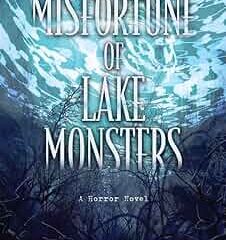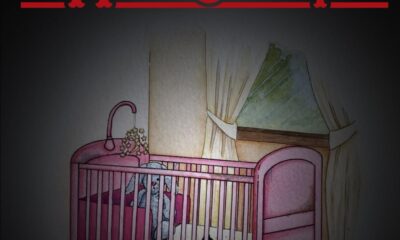
Pride Month Never Ends – The Return of the LGBTQ+ horror reads
More Videos
Published
3 years agoon
By
Audrey III
June has passed in a rainbow flag covered coffin and as corporate entities put away their LGBTQ+ allyship for another year, it’s worth remembering that there’s plenty of small ways you can keep supporting those queer horror works that may get recommended to you but are forgotten by the time Pride month ends. This year I decided to spend all of Pride month reading so I would have plenty of recs to keep up the barrage long after the rainbow flags come down. Perhaps the biggest bonus of my month spent working on my queer horror to be read list was all the great works I found in addition to the ones I intended to read. Here’s the first, but far from the last, of my LGBTQ+ horror book list. On with the barrage!
Vintage: A Ghost Story by Steve Berman
I can’t tell you how far I was into this book before I realized the main character was never named. But, when you’re a gay Goth teen who’s dropped out of high school and left home after your parents discovered your sexuality, is now living with your aunt while working at a vintage clothing shop, and have a crush on a ghost you met while walking alone on an empty strech of highway one night, what do names really matter?
Vintage may sound like something out of a Christopher Pike novel, but I think you’ll find it’s something far more. Think The Sixth Sense meets The Perks of Being a Wallflower. Our main character and his friends who populate the book are believably flawed, yet relatable, teenage personalities. That goes for the more ghostly presences as well. The prose is often much deeper and more intracrate than what you would expect from a YA novel. It’s not often I would deem something both scary and erotogenic, but the ghost sex in this one is centerinly something different, and often times frightening. As an added bonus, it mentions in the back of the book that one-fifth of the author’s royalties are donated to the Gay-Straight Alliance Network and the Trevor Project. This one isn’t to be missed.
Five out of five Cthulhu. 
A Dowry of Blood by S.T. Gibson
Oh, how I wanted to love this book! A queer retelling of Dracula from the point of view of his polycule of wives? Sounds great! Sign me up! Unfortunately, that wasn’t exactly what the book was about.
The book is told from the point of view of Constanta, a young woman whom a dark, mysterious stranger finds dying after a village raid. The stranger gives to her the gift, and the curse, of undying life. She and he-who-shall-not-be-named-Dracula spend hundreds of years together, sharing lovers of all sexes in their bed and in their stomachs. Constanta is happy, but isolated. That is until Count Noname meets another woman, Magdalena, whom Constanta conveniently falls in love with as well. This pattern repeats itself when the trio meet the young Russian man Alexei. Definitely-not-Dracula, meanwhile, grows ever more controlling and monstrous to his lovers until they realize it’s either going to have to be them, or him.
The speed at which whole centuries go by in the book makes everything seem a bit rushed. People fall in love instantly so it’s hard to tell what emotions are real and what are mere vampire glamor. The horror of having to kill to stay alive for centuries is mostly glossed over in favor of showing what a manipulative gaslighter Dracula can be and the events of the original novel are only given a single throwaway line in passing. That’s not to say vampires bonding over their continued abuse by their creator isn’t an interesting story, it’s just not the one I was expecting when I picked up the book. It was still an enjoyable read nonetheless.
Three out of five Cthulhu. 
This is Not a Horror Movie by Sara Dobie Bauer
Welcome to summer vacation in Florida! There’s the beach, lots of Stephen King books to read, the hot neighbor boy you’ve had a crush on for years, the annoying twin sister, the possibly haunted abandoned beach resort that’s eating people . . . Wait. What?
That’s just a small part of what you’re going to get in This is Not a Horror Movie, a fun rom-com slash horror slash coming of age, well, just plain slash story (if you know the other meaning of that word). Horror lover extraordinaire Emory is on his last summer vacation in Longboat Key, Florida with his family before he goes to college. Conner, the boy next door of his dreams, is going to be a huge part of that vacation, along with Vincent Price stalkers, missing homeless Vietnam vets, demonic cults, kidnappings, and no one’s first times but certainly their best times.
Sometimes a book can be just a fun romp, and that’s definitely what this book is. Most of the horror elements don’t even kick in until half-way through the book, but honestly, I didn’t even notice because I was having such a good time with the characters, who are both funny and endearing. Emory’s horror knowledge is used less as a meta reference like in Scream and more of something to bond over with Conner. Of course, that doesn’t mean it doesn’t come in handy when their lives are on the line. If you’re looking for a straight up horror story, like the title says, this probably isn’t what you’re looking for. If you’re looking for a good time and a fun summer read, then call me. I’ll happily loan you my copy of this book.
Four out of Five Cthulhu. 

Rolling in the Deep and Into the Drowning Deep by Mira Grant
A two for one special! You know what’s really scary? Mermaids. Or at least you’ll be thinking so after you read these two books by Mira Grant about a couple of documentary film crews on assignment to find mermaids below the bathypelagic zone (also known as midnight zone) in the deepest parts of the ocean of the Mariana Trench.
In what could be a prequel to the movie Underwater, or maybe Aquaman, it’s no spoiler to tell you the first of the crews of the research ship the Atargatis is met with an unimaginable tragedy. Rolling in the Deep is the novella that tells the frighting story of what happened to the Atargatis from the points of view of its crew, scientists, film crew, professional mermaid performers, and tv personalities. It’s as scientific and scary as anything by Michael Crichton, but it does leave you with some unanswered questions.
Into the Drowning Deep picks up right where Rolling in the Deep leaves off. Seven years later, another crew, much better prepared (supposedly), is sent back to the Mariana Trench to either prove or disprove what happened aboard the Atargatis. Into the Drowning Deep may be a bit long in the tooth when it comes to scientists arguing with each other, stereotypical big game hunters who are hired on as security, and evil corporations (going to need a “Does the Dolphin Die?” website now), but it does answer the bigger questions Rolling in the Deep leaves behind. And the biggest question of all that will keep you reading to the end, will they survive?
While these books are more in the traditional horror genre, they are filled with good representation of all sorts; hearing impaired characters, LGBTQ+ characters, neurodivergent characters, physically disabled characters, and many others. There’s a little something for everyone in other words.
Five out of Five for Rolling in the Deep, three out of Five for Into the Drowning Deep, giving an overall score of four out of Five Cthulhu. 
Related posts:
You may like
1 Comment
Leave a Reply
Cancel reply
Leave a Reply
This site uses Akismet to reduce spam. Learn how your comment data is processed.
Released in May of this year, You Like It Darker is the latest short story collection by Stephen King.
In the afterward King says. “You like it darker? Fine, so do I.” This sort of declaration might lead one to believe that this collection is going to be darker than his others. That we might reach depths of horror that we haven’t yet seen before, even from the King himself. This is a promise that this book does not deliver on. But that isn’t to say that You Like It Darker wasn’t still a damn fine read.
The good stories
The first story in the book, Two Talented Bastids, started everything out on the right foot. This is the story of a man named Mark. Mark looks after his father, who he lovingly calls Pop. Pop is a famous author His best friend, Butch, was a famous painter before he passed.
Everyone wants to know how two men who are lifelong friends suddenly become famous in their forties. But as far as the men in question are concerned, they’re just two talented bastids. That is, until Pop dies, and leaves a story to explain to Mark how one fateful hunting trip changed their whole lives.
Another tale I appreciated was Rattlesnakes. This is a sequel to the classic King novel, Cujo. If you haven’t read Cujo, this will spoil the ending for you. I, for instance, had not read Cujo.
Rattlesnakes is about Vic Trenton. A recent widower, he’s traveled to Florida to heal from his losses. There, he meets a lovely woman about his age (old) who appears to be not quite right in the head. She walks around around town like Delta Dawn, not with a suitcase in her hand but wheeling a twin stroller. Years ago, her twin sons were killed by rattlesnakes. And she’s never really gotten over that. So she wheels around the stroller and pretends they’re still in there. At least, everyone assumes she’s pretending.
Easily my favorite story in the book was Danny Coughlin’s Bad Dream. Imagine if you had a prophetic dream, but just one. That’s exactly what happens to Danny. He dreams of the location of a murder victim. When he goes to the location, which he’s never been to before, he finds the poor woman in question. Of course, the police find this extremely suspicious. And one detective grows so suspicious that he starts taking matters into his own hands.
The bad stories
Of course, not all the stories can be great. One that I especially disliked was Finn. This is the story of a young man with bad luck. I mean, terminally bad luck. So bad that he’s kidnapped in a case of mistaken identity.
This story just didn’t have a satisfying ending. Nor did it have a satisfying middle. There was just no real conclusion.
Another story that missed the mark was On Slide Inn Road. It’s the story of a family on a car trip to see a dying sister when they’re overtaken by some rough people outside of an old abandoned inn. This story also doesn’t seem to have any sort of cohesive storyline. It’s just the story of a family having a really bad day. It doesn’t go anywhere.
Overall, this was a collection that shows King’s patterns. He writes over and over about men who have lost their wives and their sons. Men who have survived their families and been left alone. Most of the main characters in these stories fall into that category. Perhaps in that way, these stories are darker than the ones King has written in the past. At least for him.
Fans of King’s work will love this book. I loved this book. I loved catching up with the lonely widower from Cujo. I loved meeting monsters who might or might not have crawled out of the back of a Buick. And while none of these stories were dark enough to disturb my sleep, they were good enough to keep me up reading late.

As summer approaches, there’s nothing quite like reading a book with warm campy vibes. It’s especially true if you’re lying on a sunny beach. Nicole M Wolverton’s A Misfortune of Lake Monsters matches that picture perfectly. It’s described as a creature feature with a Stranger Things-esque friend group.
Although set in modern times, I found the story felt like something out of the 80s (in a good way). Character dynamics reminded me of The Goonies and IT while the narrative combined just the right amount of adventure, romance, and horror to bring out nostalgia and comfort at the same time. Anyway, let’s dive (hehe) in!
Plot
Lemon Ziegler has one aspiration in life – to become a vet. Unfortunately, that would involve leaving her hometown, which is a problem as she is obligated to continue the family business. While such a situation is not out of the ordinary, the business itself definitely is. Lemon must impersonate Old Lucy, the town monster (a nice homage to the Loch Ness myth).
The decades-old legend about this creature swimming around in the lake is keeping tourism in the town alive. Because of this, poor Lemon has no other choice but to follow in her family’s footsteps. She keeps this secret from everyone, including her best friends, Derrin and Troy. The latter is harbouring feelings for Lemon that are stronger than friendship. As he is a teenage boy though, he is too afraid to make a move (much to Darrin’s enjoyment).
Things take an unexpected turn when a real monster shows up, hungry for blood. As one could guess in these kinds of stories, no one believes Lemon at first. This only allows the creature to claim more victims (and yes, I feel the saddest about the poor dog). Once the adults finally decide to do something, it alerts the FBI, which makes the situation more difficult for our gang. Unsurprisingly, they are the only ones who can stop the monster from wreaking move havoc.
In the midst of the riveting adventure, we also see Lemon go through a character arc. She stands up to her grandfather, allowing him to see her as an adult for the first time ever. There’s also the blossoming of her and Troy’s romance. The pair awkwardly navigate the transition from friendship to romance in an adorable way. At its heart though, this novel is about family, blood or otherwise, and how strong connections can sometimes be the only way to save your life. After all, who could defeat a multidimensional monster by themselves?
Overall thoughts
I had a blast with A Misfortune of Lake Monsters as it combined all the components of making an effective adventure story with enough heart to make you care about what happened to the characters. They are sympathetic yet entertaining and their relationships feel organic down to the dialogue that, while a tad cheesy, is oozing with charisma.
The reasons I am giving it four stars are more individualistic. I tend to go for a darker type of thriller/horror and this story, although not short of gore, ultimately steers in a more heartwarming direction. It’s something I anticipated knowing the age range and found fitting with what the narrative was going for.
I also would have liked a slightly different as I feel the story entered more of a sci-fi subgenre in the last third. While that’s fine overall, it is not my first choice of horror. Considering these things are more down to my personal preferences as a reader, I would absolutely recommend this book. I’m excited to see what the authors does next!
 (4 / 5)
(4 / 5)
Dear readers, the time has come for some answers. At least, that’s what the teaser for the new installment of Monastery says. As usual, it delivers what it promised and more as we untangle the past and its connection to the present. Without any further ado, let’s talk about it, shall we?
Plot
We start the episode with a blast from the past. Cassandra and Celeste (Nicole’s aunt and Arthur’s lover for those with short-term memory) are in the hospital because of Celeste’s pregnancy complications. Cassandra promises her former best friend that she will ruin her all the while we find out Francis’s real parentage. The picture is finally starting to come together.
As we are back in the present day, our group is more scattered than ever. Thomas is his father Walt’s prisoner while David is still running around looking for Rocky. Fred on the other hand is just looking for any place to crash, homelessness and all. Our dethroned beauty queen Nicole is hiding away from everything – including her shame. Last but not least, little Henry is spending his time taking care of Nana Beth. Guessing that is his redemption for trashing all the evidence of Albert’s murder gathered so far. Although frustrating, his actions are understandable – the poor kid is traumatized and just wants some peace.
George Turner’s murder is still an active investigation. It is obvious that this cover-up wasn’t nearly as successful as Albert’s. I sure as hell hope that Francis gets his comeuppance sooner rather than later. Not particularly because Turner didn’t deserve it but so the rest of the characters would be safe from him. Although as I’ve said before, his clear descent into sociopathic tendencies is kind of fascinating to watch.
We also get an interesting development in what so far has been a tiny background detail, which is the Monastery Werewolf. As the creature comes to visit Rocky, we find out our resident star dog considers it family. Not going to lie, it took me a few reads to understand what this means. Now I’m getting all sorts of ideas as to how the supernatural ties into the rest of the story.
Speaking of the supernatural, it is none other than Madame Witch who frees Thomas from his captivity. Well, her contribution is indirect as she sends his best friend Alfie to help instead. Although I’d say currently the two should set their dynamic status to ‘it’s complicated’. As soon as he’s free, Thomas is immediately back in his detective mode. For arguably the first time he gets some real answers as we find out the whole backstory of Albert/Celeste/Cassandra triangle. I won’t go into details as that trio deserve their own article but let’s just say it gives Cassandra a big ass motive for killing her husband. Not to mention the way she took Francis from Celeste was quite brutal to read.
We reach the lead-on for the grand finale as David and Henry are coming to free Rocky. This naturally comes with a condition – they must hand Francis the key they found during the investigation. Little do they know Nicole is already there being held at gunpoint. Oh, and Fred should also be around somewhere as he was sleeping there the night before. Thomas might be a little late to the party since he and Alfie are held a knifepoint by Rick (seems like a running theme here). Nothing good can come from this.
Overall thoughts
This episode does a perfect job of setting up the big finale. It reveals everything we need to know except the main question – who killed Albert? At this point, while it of course still matters, this story is so much more than that. It’s about all the mess that this family has got themselves into, how with each mistake they kept digging deeper, and how it took a whole new generation for all of that to come up to the surface. I can only hope our investigative gang will make it out alive…

More thoughts from the author:
1. Although a minor character in comparison, Walt strikes me as someone who’s there to represent the themes of Monastery – someone who will do horrible things in the name of family. What was your intention with his characterisation, especially considering he works for justice (aka the police?)
This is why I will always defend my decision to have a large cast, as opposed to most books – when you get even the slightest sense of fleshing out a minor character, it feels so rewarding. Walt, to me, takes the crown of “father of the year”, even if he does it by locking his son up in the bedroom. He is protecting his wife’s secret, protecting his son’s innocence, and doing so by going against his core ideals – i.e., a detective covering up a murder. He’s also based on a favourite uncle of mine, so it makes me happy to give him his moment to shine.
2. Something I thought of while writing this review – the cover up of George Turner’s murder seems to be a kind of juxtaposition as to how neatly Albert’s was since the police keep discovering evidence left and right (and how Francis doesn’t particularly seem to care). Was this intentional on your part?
It all adds up to plot convenience, and I have no shame in admitting that – Albert’s murder was so neatly covered up because I needed it to go unsolved for 14 years, whereas the reader knows who killed George, so there is no need for the cover-up to be well done.
As for Francis’ reaction to the murder, he started out anxious and paranoid after the fact, but he has grown into a state of not caring, which further depicts his descent into darkness – he knows he’s close to his goal (of finding the money and leaving his family), so there is a sense of invincibility taking over. He is stepping into his main villain energy and we are here for it!
3. Alfie has been yet another background character until now and yet he is the one who rescues Thomas. To me he seems like the friend who genuinely cares for Thomas and who gives him that reality check he sometimes needs to get out of his own head. Was that at least partially why you chose to bring him in for the grand finale?
Fun fact: Alfie was originally a series regular. However, halfway through writing the series, I realised I wasn’t using him as much as I’d wanted to, so I bumped him down to recurring. But the original plan always saw him and the other regulars coming together for the big climax, which is why he is in the fold. Alfie is someone who keeps Thomas grounded (if not humbled), since Thomas has the slight tendency to, well, think he’s better than everyone else. What’s coming up for them is one of the most exciting things I’ve ever written about.
4. Lastly, it’s not so much a question but rather a well done for how you crafted the Albert-Celeste-Cassandra dynamic! I was very invested despite knowing the outcome. Weirdly enough, while hating Cassandra for how she handled it, I sort of understood why she thought that Celeste deserved it? Either way, congrats for managing to craft these love stories in the midst of all the murdery goodness.
Thank you so much. As I’ve said before, romance is not my strong suit, but I do love a soapy triangle – and if it ends with gun violence, even better! The reveal of this mystery is probably my favourite sequence in the series so far.
















Ashley Slices
July 7, 2021 at 6:46 pm
Some awesome cool stuff to look forward to. Killer mermaids? Yes please